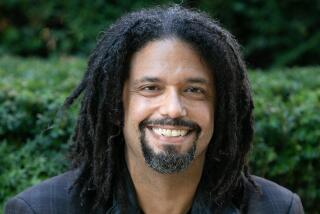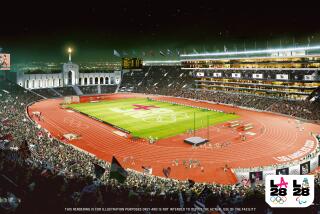NFL Doesn’t Light Up Berlin
WEST BERLIN — The mystery of the missing scoreboard at Olympiastadion remains unanswered, so let’s stick with the questions raised by Saturday’s clueless affair at American Bowl ’90.
Was there no scoreboard because the Rams and the Chiefs made one unnecessary?
Or did the Rams and the Chiefs stop scoring because there was nowhere to put the points?
Did the American Bowl planners simply forget the scoreboard in their haste to provide 50,000 Germans with Scottish bagpipe bands, Orange County cheerleaders, American rock ‘n’ roll, world-champion whistlers and Frisbee-catching dogs?
Or did we just forget that Olympiastadion is normally used for soccer, which has favored the one-finger method of scorekeeping for years?
Confusion was going to reign, regardless of when the Rams and the Kansas City Chiefs brought the strange sport of NFL football to the Deutschland for the first time. But playing this new game without keeping track of points, downs, quarters and yards-to-go was to throw the game into a new kind of darkness.
The Germans weren’t the only ones who didn’t know what was going on.
The Americans didn’t know, either.
“I couldn’t see what down it was, I didn’t know what the score was,” Ram offensive tackle Irv Pankey said. “Maybe if they start playing more football here, they’ll do a little bit more to the stadium. At least, maybe, they’ll keep track of what down it is and how many timeouts are left.”
Olympiastadion is equipped with a full-color video screen at its east end and a fine screen it is. The replays were laser sharp and brilliant, rendering U.S. Diamond Vision a rhinestone by comparison.
But the screen is all video and video was on the screen at all times, for the benefit of the Berliners in the cheap seats. The game clock was superimposed onto the action but the only other numbers visible were the ones on the field.
Matthias Theil, a Berlin college student working the game as an usher, tried to keep up, but soon abandoned it as hopeless. He had seen American football before, twice, but never without directions.
“The game promised a lot,” Theil said from a seat behind the west end zone, “but I’m a bit disappointed with the action because I can’t get who is leading. It is a very complex game to understand.”
Theil admitted that he is not much of a sports fan. “Churchill said, ‘The best sport of all is no sport at all.’ That is my opinion as well,” Theil explained with a grin. But since he was already here--and getting paid to be here--he figured, why not give it a go?
By the third quarter, Theil had decided that he may not know football, but he knows what he likes.
“One team passes and one team makes the yards step-by-step,” Theil noted. “I go for the effort of playing with the passes. It is more beautiful to see.”
That made Theil a Ram fan. In the first half, Jim Everett and Mark Herrmann combined to pass 16 times, or twice as often as Kansas City quarterback Mike Elkins. Of course, the Chiefs didn’t do much step-by-stepping, either--netting 23 yards on the ground while the Rams turned one touchdown and one field goal into an insurmountable lead.
Simone Fleigner, a 26-year-old woman from the East German city of Leipzig, was watching her first football game, most of it with a furrowed brow.
“I don’t understand much of what is going on,” she said. “But it looks very nice, very attractive.”
What Fleigner liked best were the clothes--Ram blue-and-gold clashing with Chief red-and-white. “I never saw such uniforms before,” she said. “It is more like a spectacle than a game.”
Fleigner was less enamored with the grunt work of the sport. “I don’t like when all the players jump on each other and fall over,” she claimed.
Why not?
Fleigner smiled.
“Because it looks like it hurts.”
While the Rams and the Chiefs did more hurting than scoring--the game was a 13-3 snoozer before Ram cornerback Alfred Jackson returned an interception with 1:24 left in the fourth quarter--German minds began to wander. They much preferred the leg kicks of the Ram cheerleaders, the imitation Ashley Whippets, the Chuck Berry tunes--even the scourge of the American mainland, the dreaded Wave.
“I like the show,” said Burkard Ahlcyt from his seat above the 10-yard line. “The dogs, the girls, the music. This is gut. It has a lot of life.”
Theil, however, believed that it could have been better.
“I think it should be a more effective show,” Theil said. “In Berlin, we have the (amateur) Adler team and you can see the cheerleaders more in action. Here, they are too far away. There is no feeling for the action from the cheerleaders.”
But even if they put the cheerleaders in the aisles, Theil doubts that the NFL game has much of a future in Germany.
“It has no chance,” Theil said flatly. “It is too complex. It is a very strategic game, unlike German or English soccer, which is easier to understand. Germans like to have an easier time at their games. They do not want that much thinking during the game.
“Things are too conservative here. Things are slow to change, especially in Berlin, which has been influenced by the old thinking from the GDR. I do not think Berlin will become a second Wembley for American football.”
But then at Wembley Stadium, they speak the same language.
And they have a scoreboard.
Fleigner, a fast learner, had already adopted one ancient Los Angeles custom and was heading for the exit early. Three-and-a-half quarters through one once-in-a-lifetime experience was more than enough.
Would she ever consider coming back?
“I’d rather go to a Pink Floyd concert,” she said.
All in all, a Ram exhibition game in West Berlin was just another brick in the wall.
More to Read
Go beyond the scoreboard
Get the latest on L.A.'s teams in the daily Sports Report newsletter.
You may occasionally receive promotional content from the Los Angeles Times.










